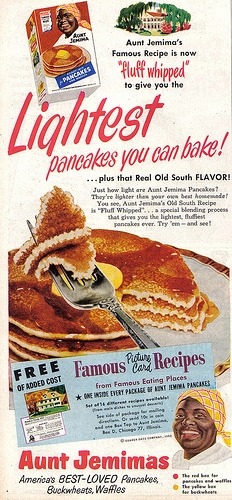Fictional Food Folk
They're grocery store institutions, roadside icons, and TV commercial stalwarts, but sometimes when you see things so often you stop seeing them. You've probably been to McDonald's a 100 times, seen Ronald on those special edition glasses from the '80s, know every iteration of the company's advertising campaigns. But have you ever asked yourself where that freaky clown came from? Where did some of the world's iconic food personalities originate? Was Uncle Ben a real guy? Chef Boyardee? Read on to find out if your favorite iconic food folks are fictional or not
Aunt Jemima
You've seen her on the front of pancake mix and syrup bottles — Aunt Jemima, the cherubic African-American woman whose face immediately summons one word: breakfast. Was she a real person? According to the eponymous company and the African American Registry, yes. Here's the deal, there was once a struggling outfit called Pearl Milling Company. One of its owners went to a vaudeville show and heard Aunt Jemima, a tune sung by a performer in blackface wearing an apron and bandanna. He decided to call the pancake flour Aunt Jemima, and the next year sold it to the R.T. Davis Milling Company. Davis tapped Nancy Green, a 56-year old storyteller and former slave, to be his spokesperson.
Ronald McDonald
Two all beef patties, special sauce, lettuce, cheese, pickles, onions on a sesame seed bun. Got it. But how did a clown hitch up with a burger chain? Willard Scott is generally credited for Ronald's genesis. He played Bozo the Clown on WRC-TV in Washington, D.C. in the early '60s. According to his book Joy of Living: "At the time, Bozo was the hottest children's show on the air. ... There was something about the combination of hamburgers and Bozo that was irresistible to kids ... That's why when Bozo went off the air a few years later, the local McDonald's people asked me to come up with a new character to take Bozo's place. So, I sat down and created Ronald McDonald." Willard Scott made three disturbing TV commercials as Ronald in 1963 and was replaced by a circus clown who gave the icon his recognizable visage. A far cry from this sexy contemporary version of Ronald from Japan. I'm lovin' it, indeed.
The Jolly Green Giant
Speaking of disturbing, a strange clown leading kids through the Golden Arches like some crazed corporate Pied Piper is nothing compared to an early iteration of the Green Giant, a stop-motion demon-faced colossus with evil eyes who awkwardly bounds over fields offering a magically-appearing can of Niblets. Since then the giant has become much more jolly. According to Green Giant the character was created in 1925 for the Minnesota Valley Canning Company and named for a variety of large peas. "Inspired by folklore and fairy tales, the Giant first appeared in advertising in 1928." Through the years, he grew friendlier, greener, and known for his "Ho, Ho, Ho!" catchphrase. The company was even renamed after him.
According to the official Uncle Ben's web site, Uncle Ben was "an African American rice farmer known to rice millers in and around Houston for consistently producing the highest quality rice." Details of Ben's life are foggy, but in 1946 the folks at Converted Rice decided to call the rice they'd been supplying to the Armed Forces Uncle Ben's Converted Brand Rice. "Uncle Ben" has since been recast as the company's board chairman. (Photo: Prêt à Voyager)
Chef Boyardee
The myth-debunking web site Snopes.com threw time at this one and found that Chef Boyardee was not, as commonly believed, a fictional creation. He was a real person, born Hector Boiardi in northern Italy in 1898. A culinary savant, Boiardi immigrated to the U.S., worked in several renowned kitchens in New York (including The Plaza) and West Virginia before opening a restaurant in Cleveland — Il Giardino d'Italia. Boiardi's spaghetti sauce was so popular that he started producing it, went into full-time pasta making, adapted his name to Boyardee, and eventually merged with American Home Foods (now International Home Foods) with whom he worked until he died in 1985.
The way the Center for History and New Media tells the Betty Crocker story, she was actually a composite of many different people. In 1921, managers at The Washburn Crosby Company of Minneapolis decided it would be more intimate to sign responses to the thousands of baking questions they received each year. They put together "Betty," which they found "warm and friendly," with the last name of a retired company executive (William Crocker). Betty Crocker's signature came from a secretary, who won a company contest. As The Center notes, Betty got her voice with a radio debut of the country's first cooking show, which featured "thirteen different actresses working from radio stations across the country. And in 1936 she got a face when artist Neysa McMein blended the features of all the women in the company's Home Service Department into one likeness. In the 75 years since, her face has changed seven times. (Photo adapted from the Center for History and New Media)
Out of the mouths of babes — almost. The famous nut just recently got a voice with Planters' new ad campaign featuring Robert Downey Jr. That's a long time to go without saying anything and stick around. According to Planters, Mr. Peanut was born in 1916 when a schoolboy named Antonio Gentile submitted a sketch to win the Planters' contest for a brand icon. A commercial artist then added the hat, monocle, and cane. Recently, Robert Downey Jr.'s Mr. Peanut has been joined by a new character, Alejandro the almond. New icon in the making? (Photo: Flickr/InOttawa.ca)

